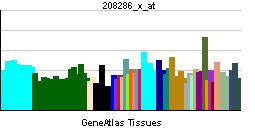Entrez 5460 | Ensembl n/a | |
 | ||
Aliases POU5F1, OCT3, OCT4, OTF-3, OTF3, OTF4, Oct-3, Oct-4, POU class 5 homeobox 1 External IDs OMIM: 164177 MGI: 101893 HomoloGene: 8422 GeneCards: POU5F1 | ||
Oct-4 (octamer-binding transcription factor 4) also known as POU5F1 (POU domain, class 5, transcription factor 1) is a protein that in humans is encoded by the POU5F1 gene. Oct-4 is a homeodomain transcription factor of the POU family. This protein is critically involved in the self-renewal of undifferentiated embryonic stem cells. As such, it is frequently used as a marker for undifferentiated cells. Oct-4 expression must be closely regulated; too much or too little will cause differentiation of the cells.
Contents
- Expression and function
- Orthologs
- Structural Information
- Implications in disease
- Animal model
- Role in Reprogramming
- In embryonic stem cells
- In adult stem cells
- References
The octamer (made of eight units) in this family of transcription factors is the DNA nucleotide sequence "ATTTGCAT", the etymology for the naming of the octamer transcription factor.
Expression and function
Oct-4 transcription factor is initially active as a maternal factor in the oocyte but remains active in embryos throughout the preimplantation period. Oct-4 expression is associated with an undifferentiated phenotype and tumors. Gene knockdown of Oct-4 promotes differentiation, thereby demonstrating a role for these factors in human embryonic stem cell self-renewal. Oct-4 can form a heterodimer with Sox2, so that these two proteins bind DNA together.
Mouse embryos that are Oct-4-deficient or have low expression levels of Oct-4 fail to form the inner cell mass, lose pluripotency and differentiate into trophectoderm. Therefore, the level of Oct-4 expression in mice is vital for regulating pluripotency and early cell differentiation since one of its main functions is to keep the embryo from differentiating.
Orthologs
Orthologs of Oct-4 exist in humans and several other species including:
Structural Information
Oct-4 contains the following protein domains:
Implications in disease
Oct-4 has been implicated in tumorigenesis of adult germ cells. Ectopic expression of the factor in adult mice has been found to cause the formation of dysplastic lesions of the skin and intestine. The intestinal dysplasia resulted from an increase in progenitor cell population and the upregulation of β-catenin transcription through the inhibition of cellular differentiation.
Animal model
In 2000, Niwa et al. used conditional expression and repression in murine embryonic stem (ES) cells to determine requirements for Oct-4 in the maintenance of developmental potency. Although transcriptional determination has usually been considered as a binary on-off control system, they found that the precise level of Oct-4 governs 3 distinct fates of ES cells. A less-than-2-fold increase in expression causes differentiation into primitive endoderm and mesoderm. In contrast, repression of Oct-4 induces loss of pluripotency and dedifferentiation to trophectoderm. Thus, a critical amount of Oct-4 is required to sustain stem cell self-renewal, and up- or down regulation induces divergent developmental programs. Changes to Oct-4 levels do not independently promote differentiation, but are also controlled by levels of SOX2. A decrease in Sox2 accompanies increased levels of Oct-4 to promote a mesendodermal fate, with Oct-4 actively inhibiting ectodermal differentiation. Repressed Oct-4 levels that lead to ectodermal differentiation are accompanied by an increase in Sox2, which effectively inhibits mesendodermal differentiation. Niwa et al. suggested that their findings established a role for Oct-4 as a master regulator of pluripotency that controls lineage commitment and illustrated the sophistication of critical transcriptional regulators and the consequent importance of quantitative analyzes.
The transcription factors Oct-4, Sox2 and Nanog are part of a complex regulatory network with Oct-4 and Sox2 capable of directly regulating Nanog by binding to its promoter, and are essential for maintaining the self-renewing undifferentiated state of the inner cell mass of the blastocyst, embryonic stem cell lines (which are cell lines derived from the inner cell mass), and induced pluripotent stem (iPS) cells. While differential up and down-regulation of Oct-4 and Sox2 has been shown to promote differentiation, down-regualtion of Nanog must occur in order for differentiation of proceed.
Role in Reprogramming
Oct-4 is one of the transcription factors used to create induced pluripotent stem cells, together with Sox2, Klf4 and often c-Myc in mouse, demonstrating its capacity to induce an embryonic stem cell-like state. This effect has also been seen with the Thomson reprogramming factors, reverting human fibroblast cells to iPSCs through Oct-4, along with Sox2, Nanog, and Lin28. It was later deterimined that only two of these four factors, Oct4 and Klf4 were sufficient to reprogram mouse adult neural stem cells. Finally it was shown that a single factor, Oct-4 was sufficient for this transformation.
In embryonic stem cells
In in-vitro experiments of murine Embryonic Stem Cells, Oct-4 has often been used as a marker of stemness, as differentiated cells show reduced expression of this marker.
Oct3/4 can both repress and activate the Rex1 promoter. In cells that already express high level of Oct3/4, exogenously transfected Oct3/4 will lead to the repression of Rex1. However, in cells that are not actively expressing Oct3/4, an exogenous transfection of Oct3/4 will lead to the activation of Rex1. This implies a dual regulatory ability of Oct3/4 on Rex1. At low levels of the Oct3/4 protein, the Rex1 promoter is activated, while at high levels of the Oct3/4 protein, the Rex1 promoter is repressed.
In adult stem cells
Several studies suggest a role for Oct-4 in sustaining self-renewal capacity of adult somatic stem cells (i.e. stem cells from epithelium, bone marrow, liver, etc.). Other scientists have produced evidence to the contrary, and dismiss those studies as artifacts of in vitro culture, or interpreting background noise as signal, and warn about Oct-4 pseudogenes giving false detection of Oct-4 expression. Oct-4 has also been implicated as a marker of cancer stem cells.
